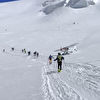Kedar Dome ascent for Parnell and Emmett
British duo Tim Emmett and Ian Parnell climb new route on the SE Pillar of Kedar Dome (6830m) in the Gangtori region of the Indian Garwhal.

 1 / 1
1 / 1
Kedar Dome
 Planetmountain.com
Planetmountain.com
| An important new route has been put up by the British duo Tim Emmett and Ian Parnell on the SE Pillar of Kedar Dome (6830m) in the Gangtori region of the Indian Garwhal. The route, graded ED+ Fr6c, M3, 2000m, was climbed alpine style over seven days on-sight and completely without aid. Tim Emmett described the crux, at 6000m, as being a smooth corner graded E3/4 6a involving some of his most demanding climbing ever. Tim Emmett is one of Britain's most strongest all-rounders with trad ascents up to E9, while Ian Parnell's climbs in the greater ranges are impressive to say the least. Testament to this is the fact that, in the past, two of his ascents have been nominated for the Piolet d'Or: one in 2003 for his new route on Annapurna SE Ridge, Nepal together with Kenton Cool and John Varco, and one in 2001 for his route "Knowledge" (ED+) climbed on the Mount Hunter's Moonflower Buttress (Alaska) together with Jules Cartwright. We spoke to Ian Parnell to find out more: How did this new route come about? A fellow British alpinist Kevin Thaw had tried this line a year or so ago and was raving about it’s potential.  I’d actually planned to climb it with Kevin but he had to pull out. Tim pretty much invited himself and despite the fact he has never been to the Himalayas - in fact he’s only climbed one alpine route - I knew he’d be a great partner as he’s so continually enthusiastic as well as being one of the UK’s top adventure climbers (numerous E9 climbs and deep water solo first ascents). I was looking for something with a bit more rock technicalities than I usually go for, but still pretty high and of course something that might be possible for us alpine style. It turned out to be the perfect route – enabling us to climb such an impressive feature – the East face - by a lightweight all free route. What about its difficulties? The crux turned out to be French 6c at over 6000m which Tim led. Luckily he turned out to be a natural at altitude. As usual we carried no bolts and had pretty light rack, only carried 6 pitons, which we placed about once each. We were very lucky to find good tent sites except for one day where we had to bivi on some poor sloping ledges halfway up the final rock headwall. Shivering the night away racked by continuous stonefall. The main difficulty on top of the crux rock pitches was following with a big rucksack which was very tiring, sometimes we cried, sometimes we vomited. Add to this the first 600m section we climbed in the night which included some terrible rock with no protection and no belay. What drew you to Kedar Dome in the first place? It isn't as well explored as other mountains in the Gangotri region. Ever since I got caught up in the fixed ropes left behind on Annapurna III by previous expeditions I've liked to try less well developed mountains, and of course that East Face is just one of the most impressive sides of any mountain I know about. What about other routes? As far as we know on the great East face there are two - the first is the Hungarian 1989 (90 % free) which takes the central spur. Left of this in 1999 Fluder and Polish team climbed a big wall capsule style. Both are very impressive looking routes but end at the top of the rock (600m below the summit) and both used a lot of equipment and fixed ropes. Photos: Ian Parnell leading at 6200m on the final rock pitches, The East Face of Kedar Dome. photos Emmett collection |
|
|||||||||||||||||||||
Latest news
Expo / News
Expo / Products
The C.A.M.P. Ikon Nova is a lightweight and comfortable climbing and mountaineering helmet.
Merino Wool Mountaineering Sock.
Ever since its market launch, the Barryvox avalanche transceiver has been among the most reliable transceivers in the world.
A lightweight and essential mountaineering backpack
A trail running backpack ideal for running in any weather condition. Thanks to the HDry membrane, this backpack is fully waterproof.
Fully adjustable harness with four buckles, ideal for mountaineering, winter climbing and via ferrata.



 Copia link
Copia link


























